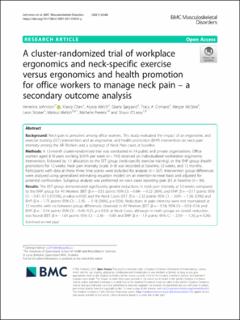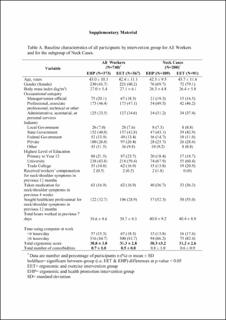Please use this identifier to cite or link to this item:
https://doi.org/10.21256/zhaw-25808| Publication type: | Article in scientific journal |
| Type of review: | Peer review (publication) |
| Title: | A cluster-randomized trial of workplace ergonomics and neck-specific exercise versus ergonomics and health promotion for office workers to manage neck pain : a secondary outcome analysis |
| Authors: | Johnston, Venerina Chen, Xiaoqi Welch, Alyssa Sjøgaard, Gisela Comans, Tracy A. McStea, Megan Straker, Leon Melloh, Markus Pereira, Michelle O'Leary, Shaun |
| et. al: | No |
| DOI: | 10.1186/s12891-021-03945-y 10.21256/zhaw-25808 |
| Published in: | BMC Musculoskeletal Disorders |
| Volume(Issue): | 22 |
| Issue: | 68 |
| Issue Date: | 2021 |
| Publisher / Ed. Institution: | BioMed Central |
| ISSN: | 1471-2474 |
| Language: | English |
| Subjects: | Neck pain; Exercise; Health promotion; Workplace; Ergonomics |
| Subject (DDC): | 614: Public health and prevention of disease |
| Abstract: | Background: Neck pain is prevalent among office workers. This study evaluated the impact of an ergonomic and exercise training (EET) intervention and an ergonomic and health promotion (EHP) intervention on neck pain intensity among the All Workers and a subgroup of Neck Pain cases at baseline. Methods: A 12-month cluster-randomized trial was conducted in 14 public and private organisations. Office workers aged ≥18 years working ≥30 h per week (n = 740) received an individualised workstation ergonomic intervention, followed by 1:1 allocation to the EET group (neck-specific exercise training), or the EHP group (health promotion) for 12 weeks. Neck pain intensity (scale: 0–9) was recorded at baseline, 12 weeks, and 12 months. Participants with data at these three time points were included for analysis (n = 367). Intervention group differences were analysed using generalized estimating equation models on an intention-to-treat basis and adjusted for potential confounders. Subgroup analysis was performed on neck cases reporting pain ≥3 at baseline (n = 96). Results: The EET group demonstrated significantly greater reductions in neck pain intensity at 12 weeks compared to the EHP group for All Workers (EET: β = − 0.53 points 95% CI: − 0.84– − 0.22 [36%] and EHP: β = − 0.17 points 95% CI: − 0.47–0.13 [10.5%], p-value = 0.02) and the Neck Cases (EET: β = − 2.32 points 95% CI: − 3.09– − 1.56 [53%] and EHP: β = − 1.75 points 95% CI: − 2.35– − 1.16 [36%], p = 0.04). Reductions in pain intensity were not maintained at 12 months with no between-group differences observed in All Workers (EET: β = − 0.18, 95% CI: − 0.53–0.16 and EHP: β = − 0.14 points 95% CI: − 0.49–0.21, p = 0.53) or Neck Cases, although in both groups an overall reduction was found (EET: β = − 1.61 points 95% CI: − 2.36– − 0.89 and EHP: β = − 1.9 points 95% CI: − 2.59– − 1.20, p = 0.26). Conclusion: EET was more effective than EHP in reducing neck pain intensity in All Workers and Neck Cases immediately following the intervention period (12 weeks) but not at 12 months, with changes at 12 weeks reaching clinically meaningful thresholds for the Neck Cases. Findings suggest the need for continuation of exercise to maintain benefits in the longer term. Clinical trial registration: hACTRN12612001154897 Date of Registration: 31/10/2012. |
| URI: | https://digitalcollection.zhaw.ch/handle/11475/25808 |
| Fulltext version: | Published version |
| License (according to publishing contract): | CC BY 4.0: Attribution 4.0 International |
| Departement: | School of Health Sciences |
| Organisational Unit: | Institute of Public Health (IPH) |
| Appears in collections: | Publikationen Gesundheit |
Files in This Item:
| File | Description | Size | Format | |
|---|---|---|---|---|
| 2021_Johnston-etal_Cluster-randomized-trial-workplace-ergonomics-neck-specific-exercise.pdf | Article | 1.33 MB | Adobe PDF |  View/Open |
| 2021_Johnston-etal_Supplementary-Material.pdf | Supplementary Material | 241 kB | Adobe PDF |  View/Open |
Show full item record
Johnston, V., Chen, X., Welch, A., Sjøgaard, G., Comans, T. A., McStea, M., Straker, L., Melloh, M., Pereira, M., & O’Leary, S. (2021). A cluster-randomized trial of workplace ergonomics and neck-specific exercise versus ergonomics and health promotion for office workers to manage neck pain : a secondary outcome analysis. BMC Musculoskeletal Disorders, 22(68). https://doi.org/10.1186/s12891-021-03945-y
Johnston, V. et al. (2021) ‘A cluster-randomized trial of workplace ergonomics and neck-specific exercise versus ergonomics and health promotion for office workers to manage neck pain : a secondary outcome analysis’, BMC Musculoskeletal Disorders, 22(68). Available at: https://doi.org/10.1186/s12891-021-03945-y.
V. Johnston et al., “A cluster-randomized trial of workplace ergonomics and neck-specific exercise versus ergonomics and health promotion for office workers to manage neck pain : a secondary outcome analysis,” BMC Musculoskeletal Disorders, vol. 22, no. 68, 2021, doi: 10.1186/s12891-021-03945-y.
JOHNSTON, Venerina, Xiaoqi CHEN, Alyssa WELCH, Gisela SJØGAARD, Tracy A. COMANS, Megan MCSTEA, Leon STRAKER, Markus MELLOH, Michelle PEREIRA und Shaun O’LEARY, 2021. A cluster-randomized trial of workplace ergonomics and neck-specific exercise versus ergonomics and health promotion for office workers to manage neck pain : a secondary outcome analysis. BMC Musculoskeletal Disorders. 2021. Bd. 22, Nr. 68. DOI 10.1186/s12891-021-03945-y
Johnston, Venerina, Xiaoqi Chen, Alyssa Welch, Gisela Sjøgaard, Tracy A. Comans, Megan McStea, Leon Straker, Markus Melloh, Michelle Pereira, and Shaun O’Leary. 2021. “A Cluster-Randomized Trial of Workplace Ergonomics and Neck-Specific Exercise versus Ergonomics and Health Promotion for Office Workers to Manage Neck Pain : A Secondary Outcome Analysis.” BMC Musculoskeletal Disorders 22 (68). https://doi.org/10.1186/s12891-021-03945-y.
Johnston, Venerina, et al. “A Cluster-Randomized Trial of Workplace Ergonomics and Neck-Specific Exercise versus Ergonomics and Health Promotion for Office Workers to Manage Neck Pain : A Secondary Outcome Analysis.” BMC Musculoskeletal Disorders, vol. 22, no. 68, 2021, https://doi.org/10.1186/s12891-021-03945-y.
Items in DSpace are protected by copyright, with all rights reserved, unless otherwise indicated.